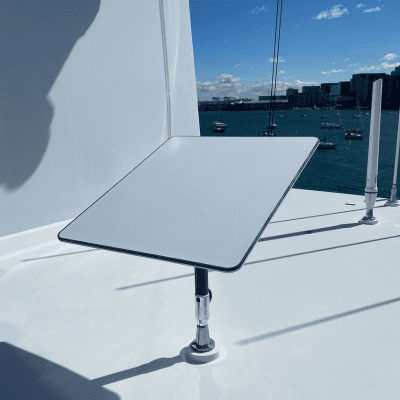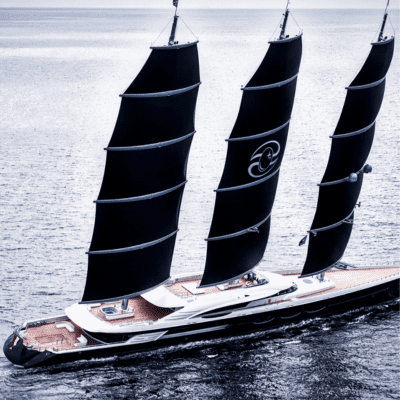Top 3 Superyacht Technology Trends for 2024
2023 continued to see significant advancements in superyacht technology, which has been a key driving force behind innovation in this space. Digitalisation, as well as sustainability, are the two biggest trends shaping the industry for 2024 and beyond. Here we discuss 3 themes that we believe will see continued interest, growth, and spark further innovation.
AI and the Superyacht Industry
2023 saw a year of groundbreaking advances in AI, as users began to adopt the technology in their masses, no industries were left untouched. The disrupter is set to have an impact on a number of areas of the sector including design, management, operations, and technology.
Last year IYC were the first company to introduce AI to yacht management with ‘Anna’, an AI yacht manager who handles administrative tasks and compliance requirements. Platforms such as this are likely to become common place, saving crew and owners significant time and resources. Analysis of ocean currents and weather patterns can also be assessed using AI, helping captains deliver the safest and most efficient routes.
The rise of AI will also have benefits to passenger experience, particularly in terms of personalisation. AI tools will be able to analyse passenger preferences and interests resulting in an increasingly personalised experience, covering dining choices, recreational activities, and off-board excursions.
Whilst already widely used on-land, we predict to see increasing use of AI voice activated controls on board, to command various aspects of the yacht using natural language. In part this was previously limited due to bandwidth availability, but with advancements such as Starlink, vessels will have the ability to control lighting, temperature, entertainment systems and more, providing a seamless experience.
On the topic of seamless integration, in addition to a well-designed and integrated entertainment system, we are also seeing a rise in ‘invisible tech’ as outlined by Ocean Independence last year. TV screens and control panels are being carefully blended into the interior design, so when not in use, they are invisible and seamlessly integrated into the walls/surfaces of the yacht.
Starlink Maritime and LEO Technology Solutions
Starlink and alternative LEO technology solutions have been a big industry talking point for the past few years, and this trend is not going anywhere in 2024. LEO satellite constellations, such as OneWeb, provide superior connectivity to GEO satellites, which was the previous industry standard. LEO satellites, due to their positioning (closer to the earth, typically at altitudes of 2,000km or less), deliver much lower latency, higher speed, and bandwidth.
This increased bandwidth means that yachts can benefit from real-time system monitoring and cloud-based services. The increased speeds will play a huge component in the expansion of seamless cloud solutions and the continued digitalisation of the maritime sector.
Whilst 2022 and 2023 could be argued as a period of trialling Starlink for the superyacht sector, we predict from the response and feedback, 2024 will increasingly see vessels pause their incumbent services and implement a LEO solution. OneWeb are late arriving to the LEO market which is currently dominated by Starlink. However, OneWeb is delivered as a B2B solution and offers a number of compelling USPs such as MIRs, CIRs, SLA and 24/7 NOCs staffed by technicians and direct contact by telephone and email. OneWeb can also offer true global coverage (excluding Russian and North Korea), so the service can deliver connectivity in areas not supported by Starlink, such as Africa, Middle East, Turkey etc.
Faster internet connectivity has also been applauded for its impact on crew welfare, with the product enabling crew to better connect with life onshore. The Marine Labour Convention Code (MLC 2006) was amended in June 2022 whereby “…Shipowners should provide seafarers on board their ships with internet access…” and “seafarers’ recreational facilities, amenities and services, including social connectivity…shall be provided on board for the benefit of all seafarers”. This is a huge step forward across the entire maritime crew sector.
Starlink pricing is also highly competitive, with plans starting at £247 a month and hardware costs of £2,470. Anyone familiar with traditional VSAT airtime pricing and the corresponding antennas will note this is vastly cheaper. A cheaper product that has shown to produce significantly faster speeds is a very compelling proposition for captains, owners, and crew. The service has also been applauded for its impact on crew welfare, with the product enabling crew to better connect with life onshore.
A number of large shipping companies are also adopting the technology at scale, Hafnia will rollout Starlink across its entire fleet and Marsek have announced plans to add Starlink to more than 330 ships by early 2024.
Are you ready to try Starlink? We offer commercial and premium plans, and have a dedicated team of specialists ready to install Starlink. Learn more.



Sustainability and the Superyacht Sector
Sustainability has long been a hot topic across an industry that by design has had a negative impact on our oceans, due to the rise of motorised mega yachts in modern years. Whilst the concept of electric boats dates back to the late 19th century, when engineers began experimenting with electric propulsion, it is only in more recent years where the concept has gained international interest. As all sectors come under pressure regarding their green credentials, the International Maritime Organisation (IMO) have set an ambitious net-zero goal for 2050.
Data is suggesting that younger superyacht clientele are more environmentally conscious, resulting in an increasing interest in sailing yachts powered by alternative fuel sources, rather than their often diesel heavy motor yacht counterparts. The Maltese Falcon and Black Pearl are both examples of the golden standard when it comes to sustainable and innovative design.
In additional to the obvious changes in yacht engines and fuel consumption, sustainability will begin to creep into every facet of the yacht build process, from the fabrics used in the interior, to sustainable practises in shipyards. From an IT technology perspective, futureproofing will be a key component to lower environmental impact. By this we mean all yachts are fitted with technology that is adaptable, for example, to changes in bandwidth availability and demand. With data transfer and storage itself contributing to carbon emissions, we should see further innovation to improve it’s impact such as energy-efficient hardware, improved efficiencies in workflows and compression techniques.
If you’re interested to learn more about the tech trends on the horizon and how they can positively impact your onboard connectivity and IT infrastructure, please contact our sales team at sales@oceanweb.com.
Recent Comments